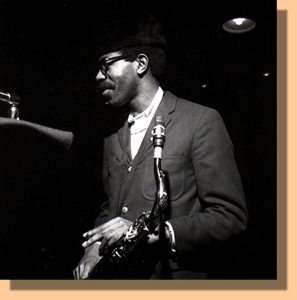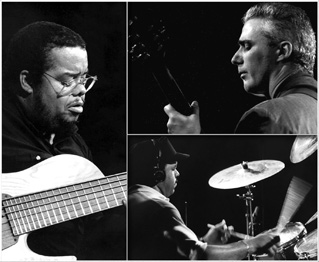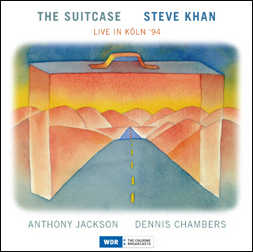Steve Khan's lead sheet:
"Caribbean Fire Dance"(Joe Henderson)
I don't believe that I will ever forget the day that I bought the LP version Joe Henderson's monumental 1966 recording "MODE FOR JOE"(Blue Note), while attending college at U.C.L.A.! In those days, I could buy an LP for only $2. And so, with one $20 bill, I could possibly arrive back home with 10 LPs. It was the most incredible time of discovery. I have to confess that, having then grown-up and lived my entire in Los Angeles, I bought this recording having known little or nothing about Joe Henderson, simply because I thought that he looks so "cool" in his winter hat. How embarrassing to have to admit that, but it's the truth. When I arrived home and I began to explore the LPs which I had just purchased, "MODE FOR JOE" really escaped me. Especially the title track which appears in the 2nd slot. I just didn't get it, I could not find my way to connect with it. It wasn't until sometime later that I did connect with Joe Henderson, his playing and his writing in a big, big way!!! His influence in these areas, I carry with me to this day. Many years later, in my early days in New York during the '70s, I had the honor and privilege of sharing the bandstand with Joe during several Monday Nights when we were both on-again/off-again members of the Gil Evans Orchestra appearing regularly at the Westbeth Theater. Over time, I gravitated towards Joe's composition, "Caribbean Fire Dance" though I can't really say exactly why. Looking back, perhaps it was the influence of Latin music? Perhaps it was the very ambiguous sense of harmony which is omnipresent in all sections of the tune and pervades the soloing as well? How embarrassing to have to admit that, but it's the truth. When I arrived home and I began to explore the LPs which I had just purchased, "MODE FOR JOE" really escaped me. Especially the title track which appears in the 2nd slot. I just didn't get it, I could not find my way to connect with it. It wasn't until sometime later that I did connect with Joe Henderson, his playing and his writing in a big, big way!!! His influence in these areas, I carry with me to this day. Many years later, in my early days in New York during the '70s, I had the honor and privilege of sharing the bandstand with Joe during several Monday Nights when we were both on-again/off-again members of the Gil Evans Orchestra appearing regularly at the Westbeth Theater. Over time, I gravitated towards Joe's composition, "Caribbean Fire Dance" though I can't really say exactly why. Looking back, perhaps it was the influence of Latin music? Perhaps it was the very ambiguous sense of harmony which is omnipresent in all sections of the tune and pervades the soloing as well?
As the years went by, I became so fascinated with this recording and this composition that I actually transcribed all the parts. The Joe Henderson version must have been quite an undertaking because the instrumentation and personnel featured such greats as: Lee Morgan(Trumpet); Curtis Fuller(Trombone); Bobby Hutcherson(Vibes); Cedar Walton(Piano); Ron Carter(Ac. Bass); and Joe Chambers(Drums). I loved the way the three horns were voiced and, of course, the montuno-oriented keyboard parts performed by Cedar Walton. At some point in time, I began to attempt to play the tune while condensing all the parts, as best as I could, on the guitar. In the end, the way I felt that I could come close to accomplishing a fair interpretation was by having the electric bass absorb portions of the piano part. By January 12th of 1992, I was ready to attempt to record the piece for the first time with Anthony Jackson(Contrabass Guitar);Dennis Chambers(Drums); and Manolo Badrena(Perc.). For the longest time, I have been extremely proud of that version and performance. However, when Anthony, Dennis and I toured Europe during May of 1994, we somehow took the arrangement to new levels. And now? I am more proud than ever before. Our trio version now appears on the just released double "live" CD entitled "THE SUITCASE" which was recorded originally as a radio broadcast for WDR in Köln, Germany on May 17th, 1994. As this tune is one of the signature pieces for the recording, I felt that it would be great to share my lead sheet with everyone in hopes that something positive can be gained by those who make the effort to investigate. However, more than anything, I urge anyone and everyone to go back and investigate Joe Henderson's original version!!!
It seems so strange to be sitting here now, awaiting the release of "THE SUITCASE" in the year of 2008, and looking at that 1994 date, it now hardly seems far away from the performance on the "HEADLINE" recording in 1992. Over the course of the time spent touring with Anthony Jackson and Dennis Chambers during the '90s, our interpretation of "Caribbean Fire Dance" was always located at or near the end of one of our sets of music. It is perfectly designed for a long drum solo - the type of drum solo where Anthony and I can simply leave the stage to Dennis until the signal comes to get back out there and close out the tune. Though I've stated this before, elsewhere, it is one of the true privileges that this performance, originally recorded for a WDR live radio broadcast, is presented in its pure and unedited form. All 17:44 is there, and ready to be listened to. When a concert performance is going to last some 2-1/2 hours, not every single piece of music has to be laden with long guitar improvisations, so my concept here is to simply attempt to play something of some substance and intensity, and then to find a good 'drop-off' point at which to leave Anthony and Dennis. And eventually, of course, to leave Dennis to his own devices. It is now my sense that, over the course of this tour of 3 weeks, we crafted an arrangement which, after the head has been played, the guitar improvisation begins with Dennis and I playing, within the form of the A-A-B-A tune, as a duo, and Anthony rejoins us as each [B] section arrives. As the solo progresses, Anthony plays with us for several full choruses. When I leave the solo, Anthony and I supply Dennis with a series of improvised accents at each [A] section to give his solo a place to begin, and a sense of a connection to the tune. This also affords Anthony and Dennis the opportunity to display their brilliant rhythmic chemistry. While listening, it can seem as though Dennis has gone off on his own, and yet, suddenly, Anthony is right there for a key hit/accent coming out of the [B] section. Even for me, as a participant mind you, it always seemed remarkable. When a concert performance is going to last some 2-1/2 hours, not every single piece of music has to be laden with long guitar improvisations, so my concept here is to simply attempt to play something of some substance and intensity, and then to find a good 'drop-off' point at which to leave Anthony and Dennis. And eventually, of course, to leave Dennis to his own devices. It is now my sense that, over the course of this tour of 3 weeks, we crafted an arrangement which, after the head has been played, the guitar improvisation begins with Dennis and I playing, within the form of the A-A-B-A tune, as a duo, and Anthony rejoins us as each [B] section arrives. As the solo progresses, Anthony plays with us for several full choruses. When I leave the solo, Anthony and I supply Dennis with a series of improvised accents at each [A] section to give his solo a place to begin, and a sense of a connection to the tune. This also affords Anthony and Dennis the opportunity to display their brilliant rhythmic chemistry. While listening, it can seem as though Dennis has gone off on his own, and yet, suddenly, Anthony is right there for a key hit/accent coming out of the [B] section. Even for me, as a participant mind you, it always seemed remarkable.
Let us take a look at this really interesting composition. In essence, all the [A] sections are the same. On the original recording, Lee Morgan's trumpet is assigned the melody and Joe's tenor sax and Curtis Fuller's trombone play the moving inner voices. Cedar Walton's piano part supplies what is so interesting about this singular sonority over what is, in essence, an A7(#9) chord. However, key to it all is the movement between C#(3rd) and D-natural(4th). To have the 4th appear over any #9 chord is extremely rare. And yet, it's there. When you couple this with the fact that Ron Carter's original acoustic bass part concentrates between his low open 'A'-string and Eb. So, now you have A7(#9b5) and yet, the 'sus4' is there too. When I tried to reduce all of this to a single guitar presentation, I felt compelled to pass portions of the harmonic responsibilities to Anthony Jackson's contrabass guitar. And, so when viewing the guitar and bass parts, you can see how the notes were covered and realized in sound. I know that this might appear to be hard to believe but I had never ever heard a playback of this recording until 2007! I guess what struck me the most was just how fast these tempos had become compared to the original recorded versions, and I'm speaking of all the recorded tunes that appear.
The [B] section of "Caribbean Fire Dance" is no less fascinating and perhaps far more enigmatic, and to attempt to attach standard chord names to each voicing becomes so very difficult. If you go back and study the soloing concepts offered by Henderson, Morgan, Fuller, Hutcherson, and Walton, it is so very interesting to see how each one treats the [B] section. The melody is stated with tightly voiced horn harmonies and again, Lee Morgan carries the top voice. His voice relies heavily on the note D-natural. So, when soloing over this section, that note and the C-natural(which also appears) are touchstones on which one can rely. If one only looks at the horns, it can seem like the section is based around a Gm7 oriented sonority. But, the movement of the bass and piano chords often goes against that thinking. The moment you hit bar 3 of either 4-bar system of [B] and there is suddenly an E major sound, all bets are off relative to Gm7. And then, the 10ths played by the piano seem to indicate Dbmaj-Ebmaj-E-Bb. When you have that tritone relationship between E and Bb, it is almost as if the harmony suggests some relationship between E7 and Bb7. But again, keep in mind that the D-natural in the melody is in both of those chords. The most curious thing is to see the D-naturals against the Db-F 10ths. Intellectually speaking, that just shouldn't work, and yet, it does!!! Bravo Joe Henderson!!! The section closes with a cadence to an E7(#9) chord which certainly, under any circumstance would lead us back, and comfortably so, to the A7(#9) chords of the [A] section.
The approach to just how one might solo over the [A] could widely vary depending upon the player. Joe Henderson, on the original version, offers a variety of ideas, but chief amongst them is his usage of the whole-tone scale[A, B, C#, Eb, F, G] in places. At [B], Joe places much more emphasis on D-naturals and F-naturals the first time through, but during his 2nd chorus, he plays more G minor pentatonic ideas over the section. Lee Morgan employs a much more blues based approach to [A ], so one hears a good deal of the blues scale[A, C, (C#), D, Eb, E, G]. Ironically, even though he follows the Henderson solo, Morgan plays whole-tone ideas[Bb, C, D, E, F#, Ab] over [B] which would seem to indicate that he hears the sense of E7-Bb7 more than Gm7 and G minor pentatonic based ideas. Curtis Fuller, over [A] employs a sense of either the A altered dominant scale[A, Bb, C, C#, Eb, F, G] or Bb melodic minor[Bb, C, Db, Eb, F, G, A] - they are one and the same. I suppose one could say that my approach to improvising over this tune is my own amalgam of all these devices and tools. But, more than anything, I try to never lose the sense of being in the rhythmical flow with Anthony and Dennis. That is paramount to me!
The journey to arrive at actual release dates has not been an easy one. The release date for Japan stands as February 20th, 2008; and the release dates for the U.S. and Europe stand as March 4th, 2008. As it always is, the initial release of any recording is a really wonderful time. It is full of anticipation and hope. With this release, those elements are not different but perhaps they are elevated a bit more because of the reaction from the people who attended these concerts during that tour in 1994, and of those who have listened to the various radio broadcasts from WDR over the years. And then, of course, the fans who have written me after purchasing the illegal bootlegs. It has all led me to believe that something special happened on that last night. Now we're going to see what kind of reaction it all gets as a legal and most legitimate double CD is officially released. From Anthony, Dennis and myself, and all those involved in the post-production aspects, we welcome you to this event and hope that you will enjoy and treasure this recording forever and always!!!
[Photo of Joe Henderson by Francis Wolff, Englewood Cliffs, New Jersey, January 27th, 1966.
Photos of Steve Khan-Anthony Jackson-Dennis Chambers by Wolfgang Gonaus taken at the Metropol in Vienna, Austria - May 11th, 1994
Collage by: Youngsuk Fallis]
|

